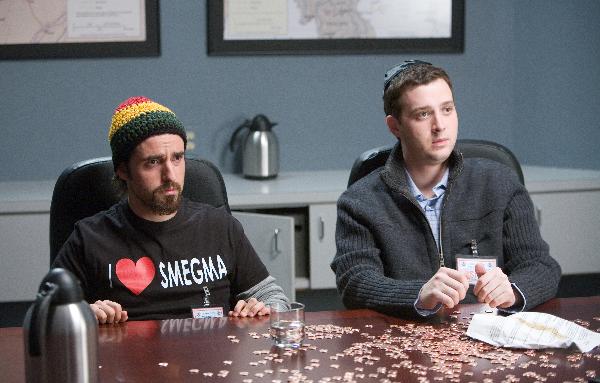Stereotypes drive Harold and Kumar sequel

Image: Stereotypes drive Harold and Kumar sequel::Courtesy of New Line Cinema
April 29, 2008
First they went to White Castle. Now, Harold & Kumar have been mistaken for terrorists, taken to Guantanamo Bay and must go on a journey to win back their freedom.
Some parts of this movie are hilarious. One scene that stands out is the one in which Harold and Kumar’s car breaks down in front of a bunch of thugs who pick up crowbars and approach the now stranded protagonists. Harold and Kumar run away in fear, only for it to be revealed that the “thugs” wanted to help fix their car. One “thug” rolls a new tire in front of the tool-holding group and asks where the two guys went. The joke is about contrast from stereotypes we’ve come to expect from movies, TV and general culture. It surprises us, provides us with a new epiphany and is very funny.
The problem is that while the movie often surprisingly deviates from stereotypes, it just as often plays right into them. One scene includes a man from the South who gets mad at stereotypes about Southerners marrying their relatives and having inbred children. This is shortly before it’s revealed that this Southerner is married to his sister and has an inbred child.
Another scene depicts a racist interrogator trying to tempt two Jewish men with about 7 dollars in change. The Jewish men of course scoff at the interrogator. The joke is obviously about the ignorance and stupidity of the interrogator. It’s funny. But then, when the interrogator isn’t looking, the Jewish men discretely scoop in change from the table. With that gesture, the joke becomes as ignorant as the interrogator it was just making fun of. This joke in fact cancels out the previous joke because the interrogator we were laughing at before no longer seems ignorant: He’s proven correct about his racist assumption.
Throughout history there have been literally millions of jokes based on the stereotype of Jews loving money. Stereotypes are stereotypes because they are widely held assumptions. They don’t surprise us or provide us with anything new to think about. A few of the scenes in this movie are pretty fresh, but in other scenes, just when we are about to receive an original view that contrasts with our assumptions, we instead receive the same old stereotype. Yawn.
Another major flaw is that this movie expects viewers to suspend their disbelief through events that are just too unbelievable to palate. In one scene, Harold and Kumar accidentally fall out of a plane and happen to parachute through the roof of President George W. Bush’s cabin in Texas. If that isn’t unbelievable enough, when President Bush sees them he quickly goes from furious to inviting them into his game room because he doesn’t want Dick Cheney to find him. If a stranger parachuted through your roof, would you whisk them away into your game room? The president certainly wouldn’t.
In some movies, like “James and the Giant Peach,” we allow ourselves to suspend disbelief much further because unrealistic things are within the rules of these worlds. In other, more realistic worlds, our suspension of disbelief is narrower in limits. In “Dumb and Dumber,” two idiots react idiotically to a realistic environment, and the environment reacts realistically back.
Like in “Dumb and Dumber,” the world of “Harold & Kumar” is supposed to be realistic; so when unrealistic things happen, we can’t help but lift an incredulous eyebrow.
There were some very funny moments in this movie, but its flaws hold it back from being something truly remarkable or recommendable. See it if your friends really want to, but don’t go out of your way for it.
Jesse Fernandez can be reached at [email protected]




























































































































